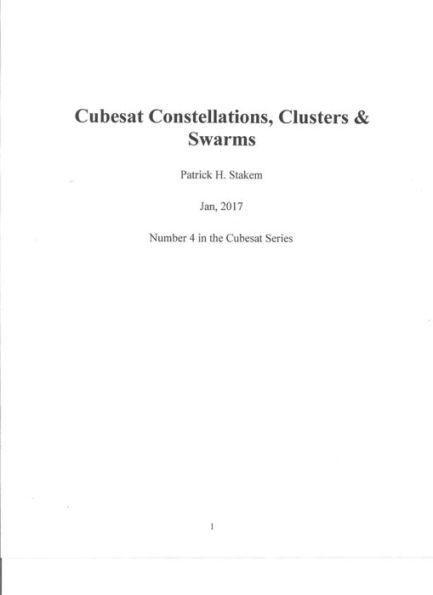Cubesat Constellations, Clusters & Swarm
This book discusses the application of Cubesat Clusters, Constellations, and Swarms in the exploration of the solar systems. This includes the Sun, the 8 primary planets and Pluto, many moon, the asteroid belt, comets, the ring systems of the four gas giants, and comets. There is a lot to explore. U.S. Spacecraft have been to all of the planets in the solar system. Although the planets (and Pluto) have been visited by spacecraft, Earth's moon has been somewhat explored, and many of the other planets' moons have been imaged, there is a lot of "filling in the blanks" to be done. Here we explore the application of groups of small independent spacecraft to take on this role. Some of the enabling technology for cooperating swarms is examined. The big picture is, Cubesats are not just secondary payloads anymore, They may be small, but a lot of them together can accomplish a lot. We'll discuss the technologies to make this happen.
Just after this book was published, an event occurred requiring an update. Such is the march of technology The Indian Space Research Organization (ISRO) launched 104 Cubesats from their Sriharikota launch site into Polar orbit. This was a new record for the number of satellites to orbit in one mission. It also validated the concept of Cubesats as a primary payload. They were deployed in 18 minutes.
1126449699
Just after this book was published, an event occurred requiring an update. Such is the march of technology The Indian Space Research Organization (ISRO) launched 104 Cubesats from their Sriharikota launch site into Polar orbit. This was a new record for the number of satellites to orbit in one mission. It also validated the concept of Cubesats as a primary payload. They were deployed in 18 minutes.
Cubesat Constellations, Clusters & Swarm
This book discusses the application of Cubesat Clusters, Constellations, and Swarms in the exploration of the solar systems. This includes the Sun, the 8 primary planets and Pluto, many moon, the asteroid belt, comets, the ring systems of the four gas giants, and comets. There is a lot to explore. U.S. Spacecraft have been to all of the planets in the solar system. Although the planets (and Pluto) have been visited by spacecraft, Earth's moon has been somewhat explored, and many of the other planets' moons have been imaged, there is a lot of "filling in the blanks" to be done. Here we explore the application of groups of small independent spacecraft to take on this role. Some of the enabling technology for cooperating swarms is examined. The big picture is, Cubesats are not just secondary payloads anymore, They may be small, but a lot of them together can accomplish a lot. We'll discuss the technologies to make this happen.
Just after this book was published, an event occurred requiring an update. Such is the march of technology The Indian Space Research Organization (ISRO) launched 104 Cubesats from their Sriharikota launch site into Polar orbit. This was a new record for the number of satellites to orbit in one mission. It also validated the concept of Cubesats as a primary payload. They were deployed in 18 minutes.
Just after this book was published, an event occurred requiring an update. Such is the march of technology The Indian Space Research Organization (ISRO) launched 104 Cubesats from their Sriharikota launch site into Polar orbit. This was a new record for the number of satellites to orbit in one mission. It also validated the concept of Cubesats as a primary payload. They were deployed in 18 minutes.
9.99
In Stock
5
1

Cubesat Constellations, Clusters & Swarm

Cubesat Constellations, Clusters & Swarm
eBook
$9.99
Related collections and offers
9.99
In Stock

Product Details
| BN ID: | 2940157456009 |
|---|---|
| Publisher: | PRRB Publishing |
| Publication date: | 05/23/2017 |
| Sold by: | Barnes & Noble |
| Format: | eBook |
| File size: | 52 KB |
About the Author
From the B&N Reads Blog
